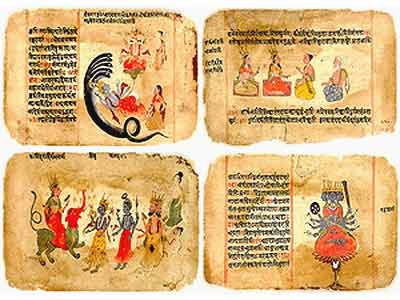 Social life was governed by the regulations of castes and ashrams. Caste system was practiced in this society too. Each caste was allotted activities according to their status in the society. Society of the Aryans was made up of the Dvijatis, the three twice-born castes of Brahmins, Kshatriyas and Vaishyas and the Ekajatis, the Sudras. Aryan society has been vividly described in Manu Smriti.
Social life was governed by the regulations of castes and ashrams. Caste system was practiced in this society too. Each caste was allotted activities according to their status in the society. Society of the Aryans was made up of the Dvijatis, the three twice-born castes of Brahmins, Kshatriyas and Vaishyas and the Ekajatis, the Sudras. Aryan society has been vividly described in Manu Smriti.
The status of a Brahmin depends upon his character and spirituality. He was known for his knowledge of the absolute, for ascetics, and universal goodwill. He acted as a teacher, judge, priest and prime minister. The Kshatriyas and the Vaishyas besides their common duties like study, performance of sacrifices, charity had their special functions, the one pursued a military career and the other could take to agriculture, trade, commerce of cattle-rearing. Service was the main function for Sudra. He was not eligible to hear sacred texts. However, he was not denied the rites of marriage, cooking of daily food in the grihya fire.
Family System of Aryans
Family System of Aryans formed the basic unit of their society. Their family was chiefly patriarchal. The families constituted a sept or a grama which later came to be used for village. The family unit was a large one usually extending over three generations and with the male offspring living with his parents. Very early marriages were not usual and people had the right to select his or her mate. Both dowry and bride-price were practiced. The birth of a son was always a grand welcome in an Aryan family because a son`s presence was essential for some important ceremonies.
The house of the Aryans was a large all-inclusive structure with the family members and the animals residing under the same roof. The hearth was venerated and the fire was continuously kept burning. The houses were usually built round a wooden framework. The room was supported by a pillar built at each of the four corners. There were also crossbeams around which walls of reed stuffed with straw were constructed. The roof of the house was made of bamboo ribs that supported the thatch. This was the usual mode of construction of houses in villages until the change to mud walls came in later centuries, when the climate became dry.
Joint family was a characteristic feature. Partition in the life of the father was disapproved. The rights of the different sons and brothers to their separate shares were recognised. Property of a widow, not having a son was liable to the crown. Daughters having brothers had did not get any share in father`s property. Inter-caste marriage was not approved.
Position of Women
The women folk were not supposed to study the Veda nor use the mantras in performing the sacraments except marriage. She was under the guardianship of father, husband and son in her old age if she becomes a widow. She could not own property except Stridhana or gifts made to her. Managing the domestic life was her main work. Widow-marriage was not common. Females of the upper castes went out wearing a veil. They were taught at homes.
Monogamy was generally followed among the Aryans although polygamy was also known and polyandry is mentioned in later writings. Marriage within related groups was strictly prohibited and was considered as incestuous relationships.
Economic Life of Aryans
Houses were made of mud, brick, stone and timber. Building art was well developed. Temples were built in the city outskirts. Agriculture was the main profession. Cotton, barley, wheat, rice, sugar-cane and vegetables were the crops grown. Sudra labourers did cultivation. The live-stock included buffalo, cow, sheep and goat. Dairying was another occupation.
Money and barter economy was prevalent at that time. Government would fix the prices in consultation with the traders. Trade routes were both by land and by water. The export trade was controlled by the government. Saffron, silk, woollens, precious stones and pearls were exported. Customs, excise and octroi duties were imposed on trade. Money was lent on interest and on promissory notes. Debtors were protected by the government from usury. Gold, silver and copper coins were used. Mines of gold silver, copper, bronze, iron and lead were worked.
Education in Aryan Society
Studentship began with the ceremony of Upanayana performed at young age which was meant for the Brahmin, Kshatriya and Vaishya pupils respectively. Students lived in the house of their teachers. They prescribed a course of discipline and austerities as regards to dress, food and habits based on Brahmacharya. The aim of education was both intellectual and spiritual development. Each term was begun and ended with formal public ceremonies. The first term began in July and comes to an end by December.
There were no regular legal institutions during the early stage of the Aryans. Custom were followed as laws and the arbitrator was the king. The chief priest was advised by few elders of the community. Punishment for committing crimes was also practiced by the Aryans. Punishment was given for theft, particularly cattle-stealing and also for homicide. Capital punishment was practiced much later. Trial by ordeal was exercised and the culprit had to prove his innocence by placing his tongue on a heated axe-head.
During this stage caste considerations entered into legal practice. The higher castes were given more preferences and were lightly punished. As in the case of caste, religious worship also followed different Aryan and non-Aryan forms.



















